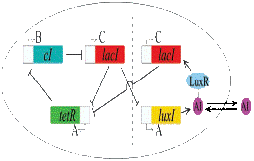McGill
From 2007.igem.org
| Line 22: | Line 22: | ||
A major enhancement to the system this year is that we plan on actually coupling the Ojalvo, Elowitz et al. - 'Represillator' system to the two-gene oscillator in a single cell. The Repressilator is a 3-gene repressing network, where each gene represses the other, and so on. In turn, this system produces very clear oscillations but is hindered by noise and instability. It is theorized that this system can become highly stabilized if coupled with the 2-gene quorum-sensing oscillator, and once working side-by-side, the 2 systems will produce highly stable, smooth, sinusoidal oscillations.<br><br> | A major enhancement to the system this year is that we plan on actually coupling the Ojalvo, Elowitz et al. - 'Represillator' system to the two-gene oscillator in a single cell. The Repressilator is a 3-gene repressing network, where each gene represses the other, and so on. In turn, this system produces very clear oscillations but is hindered by noise and instability. It is theorized that this system can become highly stabilized if coupled with the 2-gene quorum-sensing oscillator, and once working side-by-side, the 2 systems will produce highly stable, smooth, sinusoidal oscillations.<br><br> | ||
| - | <center>[[Image:fullsystem.jpg]]</center> | + | <center>[[Image:fullsystem.jpg]]<br><br>[[Image:2-genesystem.jpg]]</center> |
<br><br> | <br><br> | ||
Both the quorum-sensing Oscillator and the Repressilator, though observed in a cellular scale in our system, are important in helping understand time-varying conditions in the form of extrinsic driving forces from the environment and intrinsic rhythms generated within an organism itself. This includes specialized rhythm generators functioning in a coherent oscillatory state such as the cardiac pacemaker, also known as the sinoatrial node in mammalian hearts, and the circadian clock residing at the suprachiasmatic nuclei in mammalian brains. <br> | Both the quorum-sensing Oscillator and the Repressilator, though observed in a cellular scale in our system, are important in helping understand time-varying conditions in the form of extrinsic driving forces from the environment and intrinsic rhythms generated within an organism itself. This includes specialized rhythm generators functioning in a coherent oscillatory state such as the cardiac pacemaker, also known as the sinoatrial node in mammalian hearts, and the circadian clock residing at the suprachiasmatic nuclei in mammalian brains. <br> | ||
Revision as of 02:09, 22 August 2007
Project OverviewQuorum-sensing coupled with the Repressilator Our project is a continuation of one of the projects we presented last year: a two-gene oscillator, with an 'On' switch - LuxI gene, and an 'Off' switch - LacI, expressing a Cyan fluorescent protein when turned on for visualization. This simple relaxation oscillator makes a robust system of oscillations that can act as a 'pace maker' for more complicated oscillating systems. Quorum-sensing coupling between the systems is achieved with a diffusible artificial inducer (AI) protein made from LuxI which couples when produced, to a constitutively expressed gene in the system LuxR which can turn 'on' the system by promoting the synthesis of Lac from pLux. As Lac accumulates, it acts to turn 'off' the system by repressing the pLac controlling the synthesis of LuxI itself. Also, once AI is produced, it can easily diffuse to other cells and continue this 'On'-'Off' oscillator in other neighbouring cells, and hence increasing synchronization across a population of oscillating cells.
 
|
